- View
- Nature/Scenic Spots
- Sightseeing
- Experience
- History & Places of Interest
- Nature/Scenic Spots
-
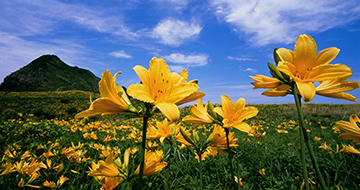 Plants Strange Rocks and Bizarre Stones
Plants Strange Rocks and Bizarre StonesOnogame
Onogame is a 167-meter high monolith projecting into the sea, and that is a sight to see. The giant rock gained two stars in the Michelin Green Guide Japon. The surrounding area is where amur daylily (Tobishima kanzo) grows in clumps, one million flowers in 500 thousand amur daylily. Many people visit there when yellow flowers come into full bloom. The blooming season is from late May until early June. Every year, the Sado Kanzo Festival is held on the second Sunday of June, when Onidaiko (deity mask dance native to Sado) and folk songs are performed.
Ryotsu area -
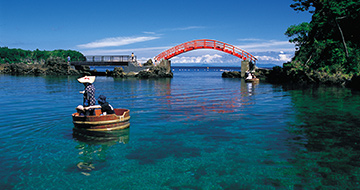 Sea
SeaYajima and Kyojima
Yajima produces good-quality Japanese arrow bamboo (Pseudosasa Japonica).The arrow which Yorimasa Minamoto, a samurai warrior in 12th century, fired to exterminate nue (a frightening imaginary bird in old stories like chimera) in the Tales of the Heike is said to be made from Yajima-grown bamboo. Kyojima is where Nichiro, a Nichiren (buddhist monk)'s senior disciple, drifted to because of a storm, when he brought a discharge paper for Nichiren, who had been exiled to Sado. Kyojima was named after legend that says Nichiro spent a night reading sutras (経 kyo in Japanese). In the beautiful setting with two islets which a red arched bridge connects, you can take a tub boat ride.
Minami Sado area -
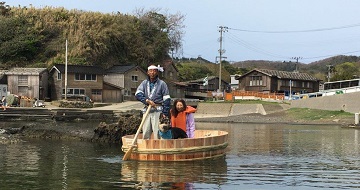 Sea Strange Rocks and Bizarre Stones
Sea Strange Rocks and Bizarre StonesHangiri (washtub boats) in Shukunegi
Take a ride on a hangiri (washtub boat) and explore the world at sea level. The hangiri have been an essential fishing tool for people living on the Ogi Peninsula since old times. Each boat is handmade using cedar and bamboo grown on Sado. In front of the retro backdrop of Shukunegi Town, you will be leisurely guided along the rocky and otherworldly shore created by the earth over a long period of time. This is an eco-friendly slow 'cruise,' navigated by a local skipper who speaks in the Ogi dialect.
Minami Sado area -
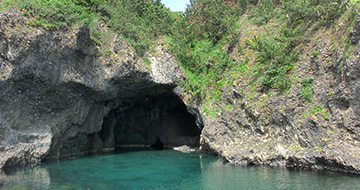 Sea Strange Rocks and Bizarre Stones
Sea Strange Rocks and Bizarre StonesRyuodo Cave
Just one among the rich variety of Kotoura caves, Ryuodo Cave is called "Sado's Blue Grotto," and is the largest lava rock cave on the island. Like the Blue Grotto in Italy, the sunlight creates a beautiful blue reflection and the waters glow brilliantly on days of mild weather and sea conditions. Sea kayak tours are available, providing participants with a chance to navigate into the cave and enjoy an otherworldly view.
Minami Sado area -
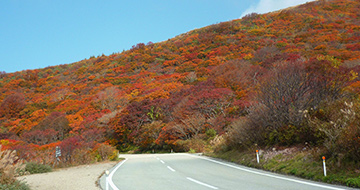 Mountains Plants
Mountains PlantsOsado Skyline
Osado Skyline is approximately 30km-long route for a scenic drive between Kanai and Aikawa. The highest point is above 900m, and you can look over the entire island, from Mano Bay, Ryotsu Bay, Kuninaka Plain to Kosado Mountains. The view from Hakuundai, a rest area with a viewing deck, is stunning. The scenery in each season such as fresh foliage in early summer and red leaves in autumn is a must-see.
Aikawa area、Kuninaka area -
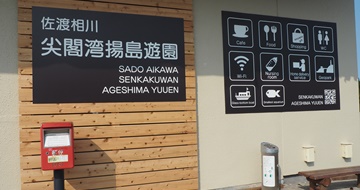 Sea
SeaSenkakuwan Ageshima Yuen
Senkakuwan Ageshima Yuen is a tourist attraction of Ageshima Kyowan (narrow bay), the fifth most scenic spot at Senkakuwan Bay. From the observation deck, you can enjoy a dynamic, panoramic view. The surrounding area is a marine park, designated as one of Japan's 100 Scenic Foreshores. You can also enjoy a cruise around the bay, and the underwater world, aboard a glass-bottom boat (for a fee). On site, there are also an aquarium, which is home to fish found in the sea surrounding Sado, and a resource centre, which displays panels about a famous Japanese film, "Kimi no Na Wa" [What is Your Name?
Aikawa area -
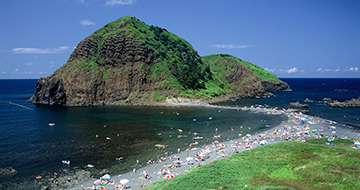 Sea Strange Rocks and Bizarre Stones
Sea Strange Rocks and Bizarre StonesFutatsugame
Futatsugame resembles two turtles nestling closely and the scenery changes according to the tide. The water around Futatsugame is the clearest in Sado, and Futatsugame Bathing Beach has been selected as one of the Top 100 Sea-Bathing Spots in Japan. Futatsugame is also listed with two stars on the Michelin Green Guide, along with Onogame.
Ryotsu area -
 Strange Rocks and Bizarre Stones
Strange Rocks and Bizarre StonesBenkei no Hasamiiwa
Benkei no Hasamiiwa is a peculiar sight located on seashore in Shimoaikawa, along Prefectural Route 45. A wedge-shaped rock is stuck between two giant rocks. Once upon a time, Sado Benkei and his company mountain priests were making their way to Mount Kinpoku for ascetic training, when a demon appeared in an ambush and requested a contest of strength. Sado Benkei threw rocks in the air, and the rocks are said to be thrown onto the beach in Shimoaikawa. A grave of a consummate governor of Sado, Ichizaemon Shizume adjoins the beach.
Aikawa area -
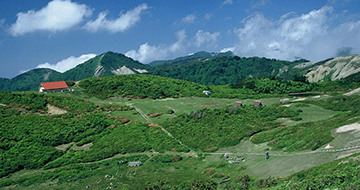 Mountains Plants
Mountains PlantsMount Donden
Mount Donden, officially named Mt Tadaramine, is the whole highland area including three mountains above 900m. As the nickname,originated from the word "donden", which means roundtop mountain, indicates, Mount Donden is located at the heart of steep Osado Mountains and solely appears with modest inclines among the mountains. The surrounding area is a treasury of alpine plants and wildflowers. Mount Donden is one of the new Top 100 Mountains and TOP 100 Mountains of Flowers in Japan and many trekkers visit there from April towards early Summer.
Ryotsu area -
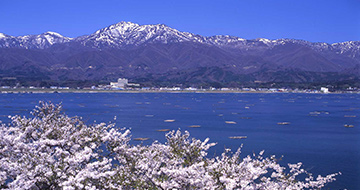 Waterfalls, Ponds and the Lake
Waterfalls, Ponds and the LakeLake Kamo
Lake Kamo, with approximately 17km of circumferences, is the largest one in Niigata Prefecture. Originally, the lake was freshwater, but it was cut open to the sea in the Meiji Period (1868-1912) in order to prevent flooding, and became a brackish lake. There is a promenade and a cycle path along the lake, and you can enjoy scenery with atmosphere, which was depicted in the poetry. In addition, oysters have been farmed in Lake Kamo since 1932.
Ryotsu area、Kuninaka area -
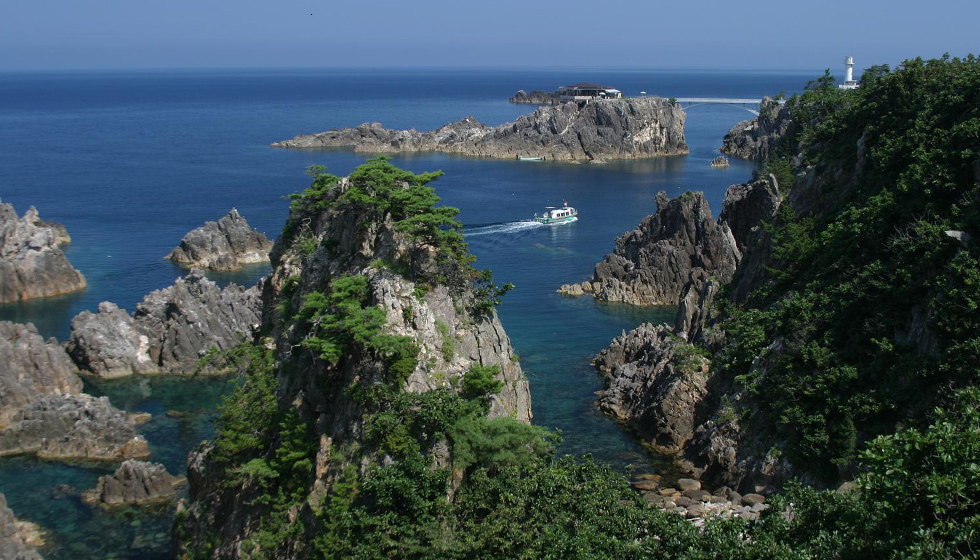 Sea Strange Rocks and Bizarre Stones
Sea Strange Rocks and Bizarre StonesSenkakuwan Bay
Five small bays stretching about 3km from Himezu to Kitaebisu are called Senkakuwan as a whole. Resembling to the beautiful steep rocks (峡尖) in Japanese) of Hardangerfjord in Norway, the bay was named Senkakuwan (尖閣湾). A series of steep cliffs like 30-meter steeples overwhelm visitors. The surrounding area is a marine park. From the viewing deck at Ageshima Yuen, you can view over the entire bay, and you can enjoy the view from different angles aboard a pleasure boat.
Aikawa area -
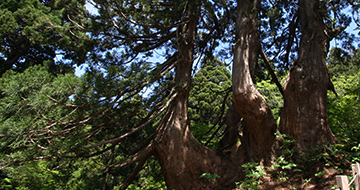 Mountains Plants
Mountains PlantsOsado Ishina Natural Cedar Forest
There is a walk path in Ishina natural cedar forest for anyone to enjoy a walk around natural cedar trees at around at 900m up in the mountain. You can get to the entrance of the path by car. Along the 650-meter long path, you can see giant trees, some of which were named "Zogesugi (ivory cedar)", "Hagoromosugi (magic robe cedar)", etc. in competition. The cedar trees were warped by strong winds and in fog, and trees unsuitable for timber remain without being cut down. Some of the trees are over 300 years old.
Aikawa area -
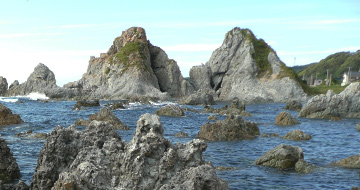 Strange Rocks and Bizarre Stones
Strange Rocks and Bizarre StonesMeotoiwa Rocks
Meotoiwa is two gigantic rocks considered to originate from a Japan's creation myth in an ancient book "Kojiki (Record of Ancient Matters)". On the right hand side is "husband" rock (22.6 meters high), and on the left hand side is "wife" rock (23.1 meters high). The rocks stands nestling up together, lapped by waves of Nanaura Coast. The rocks are said to bring luck in finding a partner. The surrounding area is spotted with rocky shores, such as Nekoiwa (Cat Rock) and Hokakeiwa (Sailing Rock) , which are, in Sado, said to originate from a Japan's creation myth.
Aikawa area -
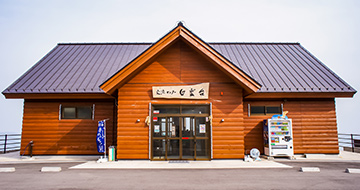 Mountains
MountainsExchange Centre Hakuundai
Hakuundai is a lodge-style building standing at about 850 metres above sea level. The viewing terrace offers a stunning panoramic view across Sado, including Ryotsu Bay, Kuninaka Plain and Ogi Peninsula. At the souvenir shop inside the building, you will find Sado specialties, such as "Okesa persimmon butter", "fig jam", and "wild grape wine". Curry over rice with the Island's black Berkshire pork, and soft ice cream made from fresh cream are special menu items at the light meal corner. Hakuundai is closed for winter as Osado Skyline will be closed due to snow.
Kuninaka area -
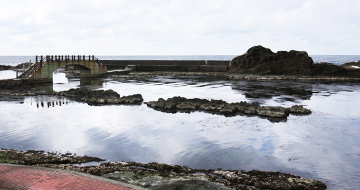 Sea Strange Rocks and Bizarre Stones
Sea Strange Rocks and Bizarre StonesSenjojiki
Known as a scenic spot since olden times, Senjojiki is a flat, rocky shore situated on the coast of Shimoaikawa at the northern tip of Aikawa Town Center. The shore is called Senjojiki (literally: a thousand tatami-mats) because of its flat, vast landform. A bridge spans over the sea toward the seawall, and from there, you can see the rolling surf of the Sea of Japan and observe the rocky shore beneath the surface. A popular relaxing spot for locals, people enjoy strolling along the trail when the sea is calm.
Aikawa area -
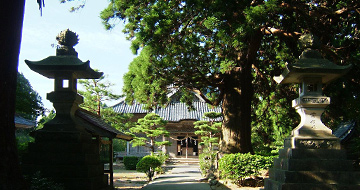 Plants
PlantsUshio Shrine
Ushio Shrine is familiar to locals, which is called "Katagami no Tenno-san," (Gozutenno in Katagami). The reconstructed hall of worship is richly embellished with elaborate sculptures depicting swimming carps and a story related to Emperor Juntoku. It reminds us of the skills and techniques of master carpenters and great craftsmen of the time. The shrine was established in 792 by dividing gods, including Okuninushinomikoto (a god of nation-building, farming, etc.), from Izumo Taisha Shrine in Shimane Prefecture and re-enshrining them here. The sacred tree in front of the hall of worship, estimated at 1,000 years of age, is revered as a cedar that brings fertility and easy delivery. The Noh stage with a hip-and-gable tiled roof in front, and a hipped roof in the back, was reconstructed in 1901. It is a Niigata Prefectural Tangible Cultural Asset and it is one of the four Noh stages in the Kuninaka area where Noh performances were regularly held. The shrine has a long track record of Noh performances. It still keeps Noh masks of Okina (an older man with a white beard) and Sanbaso (the black mask of an older man) as the shrine's treasures, both of which are designated Niigata Prefectural Tangible Cultural Assets. Bonfire Noh performances are held in the evening before the annual festival in June.
Kuninaka area -
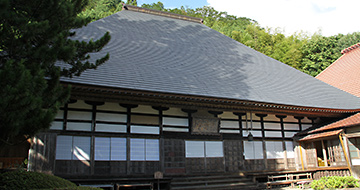 Plants
PlantsChokokuji Temple
Founded by Kobo Daishi (Kukai) in 807, Chokokuji Temple is an ancient temple which imitates Hasedera Temple in Yamato (present-day Nara Prefecture). The temple is where Zeami paid a visit after landing on Sado Island, and he mentioned the temple in his book Kintosho (Writings of the Golden Isle). The temple is also known as a temple of flowers, including peony. Chokokuji Temple owns a large number of cultural assets which shadow living history, varying from three Eleven-Headed Kannon Statues (National Important Cultural Properties), to statues of Kongo Rikishi (two wrath-filled guardians of the Buddha) made in the Heian Period (10th-12th centuries), as well as Gochido Hall. Within the grounds, there are also three cedar trees and Japanese Umbrella-pine trees, both of which belong to Niigata Prefecture's Natural Monuments.
Kuninaka area -
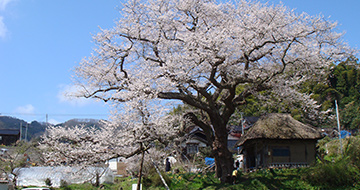 Plants
PlantsCherry Tree of Hojobo
The cherry tree of Hojobo sits in Hamochi Osaki, a place known for the Osaki Soba (buckwheat noodles) Festival. Branches stretch out as if they are cuddling up to the thatched roof house on the site where Hojobo Temple used to be. The tree is said to be 250–260 years old, measuring 21 meters tall and 6.9 meters in circumference at its base. The crown stretches 26 meters both east-to-west and north-to-south. The tree marks the timeline of farmwork, and locals affectionately call it "Hojobo's sowing cherry."
Minami Sado area -
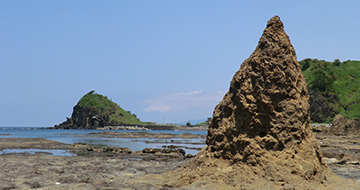 Sea Strange Rocks and Bizarre Stones
Sea Strange Rocks and Bizarre StonesOgi Coast
The Ogi Coast stretches about 16 km from Shiroyamadai in Ogi to Mikoiwa in Sawasaki. The varied coastline, formed by volcanic activity, is designated as a Japan National Monument and Scenic Site under the name of Sado Ogi Coast. The area is home to many scenic spots, such as Yajima and Kyojima, Nansenkyo, and a plateau of pillow lava in Sawasaki. The Ogi Coast is also known for its tub-boat fishing, on which people can get around rocky shores easily.
Minami Sado area -
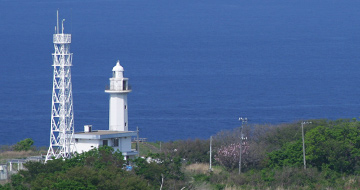 Lighthouses
LighthousesHajikizaki Lighthouse
Hajikizaki Lighthouse is an octagonal lighthouse located at Hajikizaki in the Washizaki area, the northernmost part of Sado. The lighthouse is known as the location of the film: "The Lighthouse," or "Times of Joy and Sorrow" (Japanese title: Yorokobi mo kanashimi mo ikutoshitsuki), which tells the story of a lighthouse keeper and his wife. Hajikizaki Lighthouse was built in 1919. Since then, it has been responsible for assisting the safe passage of all vessels for almost 100 years.
Ryotsu area -
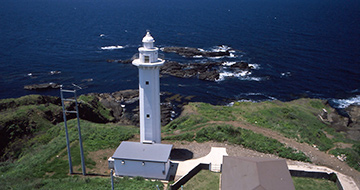 Lighthouses
LighthousesSawasakihana Lighthouse
Sawasakihana Lighthouse is situated in Sawasakihana, on the tip of Ogi Peninsula around the ending point of Prefectural Road 45 (Sado's Ring Road). The first light was flashed in 1928, and the present lighthouse building is the reconstruction from 1987. Akiko Yosano, a famous poet (1878-1942) wrote a poem inspired by the lighthouse when she visited Sado. With its height of over 24.2m, the tallest in Sado, Sawasakihana Lighthouse provides a vital role in maritime safety in the southwestern sea of Sado.
Minami Sado area -
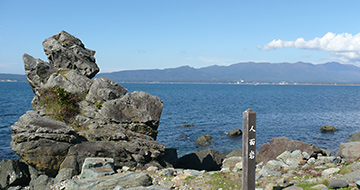 Strange Rocks and Bizarre Stones
Strange Rocks and Bizarre StonesJinmeniwa (Tateiwa)
Jinmeniwa is an oddly-shaped rock approximately 10m high, standing on the Koshi no Nagahama seashore stretching from Mano to Ogi. The rock is made of green-coloured andesite, and it is called "Jinmeniwa (human face rock), as it resembles to a person looking into far distance. Jinmeniwa is a popular location to take photos with the background of Mano Bay, and the rock stands out from all of the other numerous unique rock formations in Sado.
Kuninaka area -
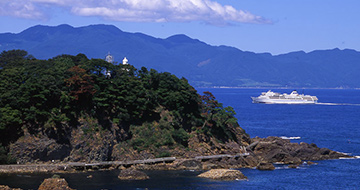 Lighthouses
LighthousesHimesaki Lighthouse
As the first lighthouse built in Sado, its light first flashed in 1895. Himesaki Lighthouse is the oldest, intact iron lighthouse in Japan. As a historical and cultural asset, it has been selected as one of the Top 100 Lighthouses in the World. The elegant, white appearance beautifully contrasts with the blue sky. The nearby Himesaki Lighthouse Visitor Centre displays valuable materials.
Ryotsu area -
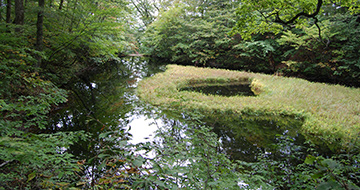 Waterfalls, Ponds and the Lake
Waterfalls, Ponds and the LakeOtowaike Pond
Take a stroll (about 600 metres) along a trail starting at a signboard on the street around Odaira Highland on Osado Skyline, and you will find the mysterious Otowaike Pond enclosed in woods of beech and Mongolian oak. A natural pond deep in the mountains, Otowaike Pond is an important area (together with the surrounding natural forest), and has been designated a Niigata Prefecture Natural Monument. In the middle of the pond, there is a floating bog, one of the largest of its kind in Japan, with over twenty species of plants, including mosses of Polytrichaceae and Climaciaceae, growing naturally upon it. There is a heart-shaped hole in the middle of the bog, which is considered to be the life-line of the islet, and is also thought to induce romantic ambience. The name of this pond is derived from lore, which says a young woman named Otowa was loved by a gigantic serpent, the master of the pond, and committed suicide by throwing herself into the water.
Kuninaka area -
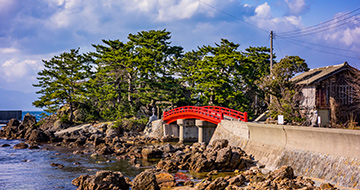 Sea
SeaTsugami Shrine
The Okawa village on the east coast of Sado thrived as a port of merchant shipping during the Edo Period (1603-1867), with shipping agents standing side by side. Tsugami Shrine, a mainstay of this village, houses two well-worshipped deities, a god of safety for vessels on the kitamaebune western shipping route, and a god of good commerce. Tsugami Shrine used to be situated behind the village, and was reputedly relocated to where it now stands sometime before the Genroku era (1688 - 1704). Farther beyond the red Tsugami bridge, the main hall lies and enshrines the sea gods of Sumiyoshi.
Ryotsu area -
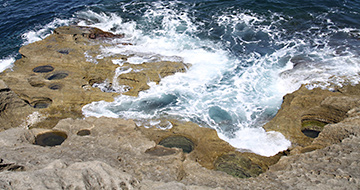 Sea Strange Rocks and Bizarre Stones
Sea Strange Rocks and Bizarre StonesA group of marine potholes in Hiranezaki
Thousands of round holes can be seen on the slope of rocks stretching approximately 500m on Hiranezaki Coast, situated to the north of Senkakuwan Bay. This is the largest group of potholes in Japan, formed by the whirl of sea water, and these potholes are designated as Japan's natural monument. Pebble can be seen in the holes, and those pebbles whirl around in the turbulence of waves and accelerate erosion. Hot water is bubbling up from the sea bed offshore, and that is a renowned spot popular for divers.
Aikawa area -
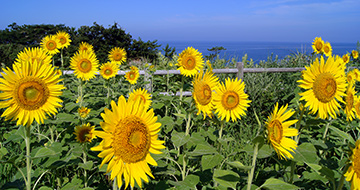 Plants
PlantsSunflower Field in Ogawa
The sunflower field in Ogawa is en route to Senkakuwan Bay from the Aikawa town center, along Sado's Ring Road (Prefectural Route 45). The sea of sunflowers with a backdrop of blue ocean is a must-see stop that cannot be passed by. With the ocean breeze softly blowing, it is a popular place for a break. Many people visit this spot every year to enjoy the view, only available on Sado in summer.
Aikawa area -
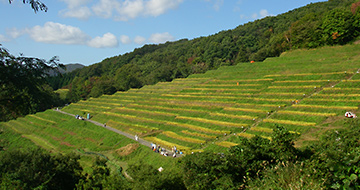
Ogura Senmaida (terraced rice fields)
Small rice fields are located side-by-side on a slope of a mountain close to Ogura Dam, along Prefectural Route 181 stretching through Hatano to Oda. Ogura Senmaida is Sado's representative terraced rice fields, and these fields are said to be cultivated to feed an increasing population as a result of the thriving gold mine in the Edo Period (1603-1867). Although the terraced rice fields were once on the verge of being set aside or abandoned, local people now work to manage and maintain the fields by introducing field ownership system from around 2000.
Kuninaka area -
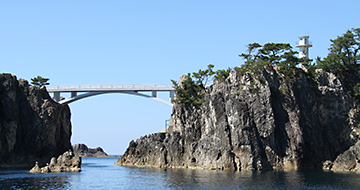 Sea Lighthouses
Sea LighthousesSado Osaki Lighthouse
Sado Osaki Lighthouse is situated within the grounds of a tourist attraction, Senkakuwan Ageshima Yuen, and you can easily walk there on a promenade. Sado Osaki Lighthouse flashed its first light in 1964. Sado Osaki Lighthouse flashed its first light in 1964. This lighthouse became widely known with a film "Kimi no Na (What is your name?)", and it is located in front of the Machikobashi Bridge (Yusenkyo Bridge), which is a filming location. The bridge leads to the viewing deck, where you can view over Senkakuwan Bay, one of the best scenic spots in Sado.
Aikawa area -
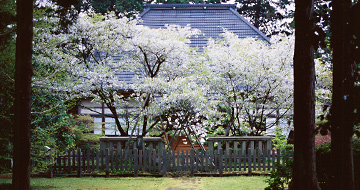 Plants
PlantsKaichoji Temple
Kaichoji Temple is an old temple of Soto Zen School located in the middle of the hill leading down to Yajima and Kyojima. The two trees of Goshozakura variety of cherry blossoms in front of the main hall are said to have been planted by Emperor Juntoku himself. Each branch produces a blend of single- and multi-layered white flowers, which are very rare, and the cherry trees at Kaichoji Temple are designated as National Natural Monument. Cherry flowers are in bloom from late April until early May.
Minami Sado area